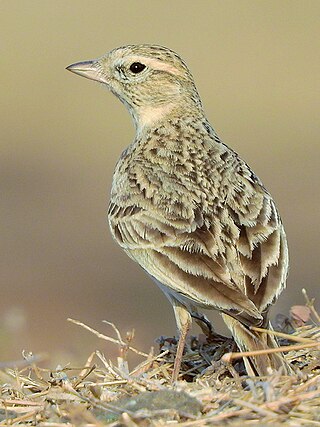
The greater short-toed lark is a small passerine bird. The current scientific name is from Ancient Greek. The genus name, Calandrella, is a diminutive of kalandros, the calandra lark, and brachydactila is from brakhus, "short", and daktulos, "toe".

World Museum is a large museum in Liverpool, England which has extensive collections covering archaeology, ethnology and the natural and physical sciences. Special attractions include the Natural History Centre and a planetarium. Entry to the museum is free. The museum is part of National Museums Liverpool.

The Vanuatu megapode or Vanuatu scrubfowl is a species of bird in the family Megapodiidae. It was formerly known as the New Hebrides scrubfowl. It is found only in Vanuatu. Its natural habitat is subtropical or tropical moist lowland forest. The species is threatened by habitat loss and egg collecting.
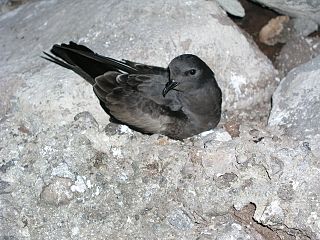
Tristram's storm petrel or ʻakihikeʻehiʻale is a species of seabird in the storm petrel family Hydrobatidae. The species' common and scientific name is derived from the English clergyman Henry Baker Tristram; the species can also be known as the sooty storm petrel. Tristram's storm petrel has a distribution across the north Pacific Ocean, predominantly in tropical seas.

The pygmy cuckooshrike is a species of bird in the cuckooshrike family Campephagidae. It is endemic to the Indonesian island of Sulawesi. Its natural habitat is subtropical or tropical moist montane forests.

The blue cuckooshrike is a species of bird in the Cuckooshrike family, Campephagidae. It is found from Sierra Leone and Liberia to eastern and south-western Democratic Republic of Congo. Its natural habitats are subtropical or tropical dry forests and subtropical or tropical moist lowland forests.

The pied cuckooshrike is a species of bird in the family Campephagidae. It is endemic to Indonesia, where it is found in Sulawesi. Its natural habitats are subtropical or tropical moist lowland forest and subtropical or tropical mangrove forest. It is threatened by habitat loss.
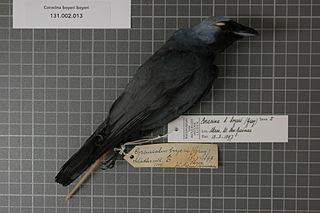
Boyer's cuckooshrike is a species of bird in the family Campephagidae. It is widely spread across New Guinea. Its natural habitats are subtropical or tropical moist lowland forests and subtropical or tropical mangrove forests.

The stout-billed cuckooshrike is a species of bird in the family Campephagidae. It is found in the Aru Islands and New Guinea. Its natural habitats are subtropical or tropical moist lowland forest and subtropical or tropical moist montane forest.
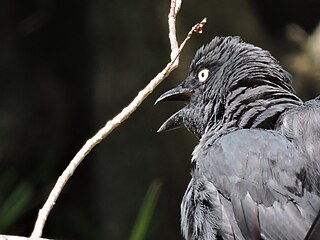
The south Melanesian cuckooshrike is an uncommon species of bird in the cuckooshrike family. It is found in New Caledonia, Bougainville Island, the Solomon Islands, and Vanuatu. The species is a large (32–37 cm) cuckoo-shrike with a long square tail and all over dark grey plumage. The eye of adults is yellow, whereas that of the juvenile is dark. Its natural habitats are subtropical or tropical moist lowland forests and subtropical or tropical moist montane forests.

The Buru cuckooshrike is a species of bird in the family Campephagidae. It is endemic to Indonesia.

The Javan cuckooshrike is a species of bird in the family Campephagidae. It is endemic to the island of Java in Indonesia. Its natural habitat is subtropical or tropical moist lowland forest.

The barred cuckooshrike, also called the yellow-eyed cuckooshrike, is a species of bird in the family Campephagidae. It is found in eastern Australia, Indonesia, Papua New Guinea, and Solomon Islands.

McGregor's cuckooshrike or the sharp-tailed cuckooshrike, is a species of bird in the family Campephagidae. It is endemic to Mindanao island (Philippines).

The Wallacean cuckooshrike is a species of bird in the family Campephagidae. It is found in the Lesser Sunda Islands and the Kai Islands. It is endemic to Indonesia.

The slaty cuckooshrike is a species of bird in the family Campephagidae. It is endemic to Indonesia, where it occurs in the Sula and Banggai Islands. Its natural habitats are subtropical or tropical moist lowland forest and subtropical or tropical mangrove forest.

The cerulean cuckooshrike is a species of bird in the family Campephagidae. It is endemic to the island of Sulawesi in Indonesia. Its natural habitats are subtropical or tropical moist lowland forest and subtropical or tropical moist montane forest. Other common names for this bird include the Sulawesi cuckooshrike, the Celebes cuckooshrike and Temminck's cuckooshrike.

The long-tailed triller is a species of bird in the family Campephagidae. It is found in New Caledonia, Solomon Islands, and Vanuatu. The Norfolk Island subspecies of the long-tailed triller, the Norfolk triller, has become extinct. Its natural habitats are subtropical or tropical moist lowland forests and subtropical or tropical moist montane forests.
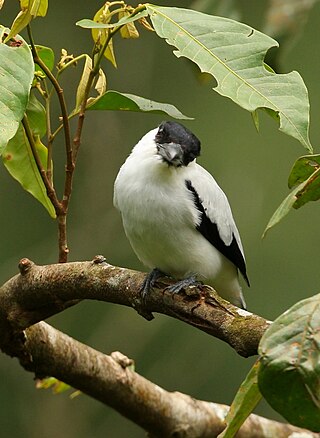
The black-crowned tityra is a medium-sized passerine bird. It has traditionally been placed in the cotinga or the tyrant flycatcher family, but evidence strongly suggest it is better placed in Tityridae.
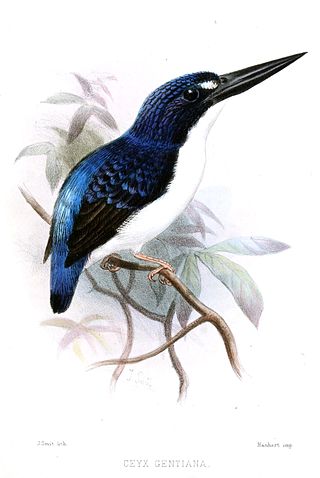
The Makira dwarf kingfisher is a species of bird in the family Alcedinidae that is endemic to Makira Island. Its natural habitat is subtropical or tropical moist lowland forests.






















